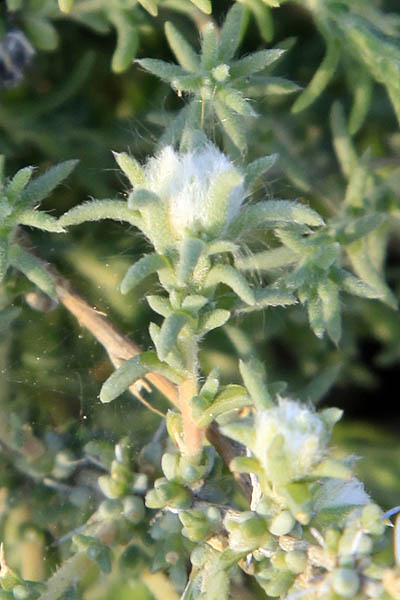Echinopsilon eriophorus, Kochia eriophora, Kochia latifolia, Wooly Bassia,
Hebrew: בסיה צמירה, Arabic: قضقاض السداة
| Scientific name: | Bassia eriophora (Schrad.) Asch. | |
| Synonym name: | Bassia eriantha (Fisch. & C.A. Mey.) Pavlov, Echinopsilon eriophorus (Schrad.) Moq., Kochia eriophora Schrad., Kochia latifolia Fresen., Londesia eriantha Fisch. & C.A.Mey. | |
| Common name: | Wooly Bassia | |
| Hebrew name: | בסיה צמירה | |
| Arabic name: | قضقاض السداة | |
| Family: | Chenopodiaceae, Goosefoot Family, סלקיים |

|
| Life form: | Annual | |
| Succulence: | Leaf succulent | |
| Stems: | 5-25cm, erect to ascending, branching from base; stem and branches sparsely covered with soft hairs | |
| Leaves: | Alternate, entire, linear, margin smooth; Leaves small, flat, subsessile or very shortly petioled, linear-oblong to lanceolate-ovate or elliptic, ± fleshy, entire, 5-20 x 2-4 mm, abruptly narrowed towards base, acute to obtuse, pubescent especially beneath and on the margins | |
| Inflorescence: | Hermaphrodite, solitary or in cymes, arranged in a panicle | |
| Flowers: | Flowering glomerules like cotton balls, hidden in thick white fleece, densely spicate; perianth segments 5, stamens 5, stigmas 2 or 3 | |
| Fruits / pods: | Fruiting perianth adherent to the fruit, rounded-oval, 1 mm long, like cotton-balls, with or without short protuberances at the back; seed c. 1 mm across, discoid, brown | |
| Flowering Period: | March, April, May, June | |
| Habitat: | Desert, Thermophilous plants | |
| Distribution: | Semi-steppe shrublands, Deserts and extreme deserts | |
| Chorotype: | Saharo-Arabian - Sudanian | |
| Summer shedding: | Ephemeral |

Derivation of the botanical name: Bassia, named for Ferdinando Bassi (1710-1774), an Italian botanist and Prefect of the Bologna Botanical Garden (ref. genus Bassia). eriophora, Greek erion, wool; phoreo, to bear; wool-bearing. eriantha , Greek erion, wool; woolly-flowered. Echinopsilon, Greek echinos, "a hedgehog or sea-urchin," Kochia, named for Wilhelm Daniel Josef Koch (1771 - 1849), a German doctor and professor of botany. latifolia, having wide leaves. Londesia , named for Friedrich Wilhelm Londes (1780 - 1807), a German botanist, author of Verzeichnis der um Göttingen wildwachsenden Pflanzen (1805). The Hebrew word: בסיה, Bassia transliteration from Bassia.
|